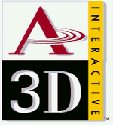
| Mr. Fixit's PC Upgrade and Repair |
| Audio Sound card: Features |
DirectSound is part of Microsoft's DirectX Application Programming Interface (API) library. It provides a
Low-Latency interface to the audio card driver. DirectSound can record and mix sound, add effects to
sound (reverb, echo, or flange), use hardware accelerated buffers, position sounds in 3D space, etc.
DirectSound3D (DS3D) is an extension to DirectSound. It allows programmers to utilize audio by writing
a single Audio API code instead of writing codes for different audio card venders. Since Version 8.0
Direct Sound 3D is now called DirectX Audio.
Low-Latency interface to the audio card driver. DirectSound can record and mix sound, add effects to
sound (reverb, echo, or flange), use hardware accelerated buffers, position sounds in 3D space, etc.
DirectSound3D (DS3D) is an extension to DirectSound. It allows programmers to utilize audio by writing
a single Audio API code instead of writing codes for different audio card venders. Since Version 8.0
Direct Sound 3D is now called DirectX Audio.
Environmental Audio eXtensions (EAX) is a library of extensions to Microsoft's DS3D API, adding
environmental audio presets to DS3D's audio positioning. With EAX a developer can set their game's
environmental setting and the audio card would use mathematical Digital Signal Processing (DSP) digital
filter presets for that environment.
environmental audio presets to DS3D's audio positioning. With EAX a developer can set their game's
environmental setting and the audio card would use mathematical Digital Signal Processing (DSP) digital
filter presets for that environment.
Over the years, Audio cards have come a long way when it comes to surround sound (a.k.a. 3D audio). The only time you heard surround
sound was in a theater. As the technology became popular, more and more people wanted surround sound at home and now on their PC.
Whether you're watching a DVD or playing a game, surround sound is becoming standard on home PCs. There are different methods
software programmers can use to create sound in 3D. DVD audio is encoded on the disc itself and the decoder instructs the audio card
which channel plays the audio. Games are more complex because the audio card must create the intended sound.
In the early years, software designers had to write code for multiple audio card vendors causing limitations on supported audio cards.
Today, new technologies allowed programmers to write a single code for the audio. The following are different methods designers use to
instruct the audio card the sound to create and which channel to play it. Audio cards will identify the methods and versions they support.
sound was in a theater. As the technology became popular, more and more people wanted surround sound at home and now on their PC.
Whether you're watching a DVD or playing a game, surround sound is becoming standard on home PCs. There are different methods
software programmers can use to create sound in 3D. DVD audio is encoded on the disc itself and the decoder instructs the audio card
which channel plays the audio. Games are more complex because the audio card must create the intended sound.
In the early years, software designers had to write code for multiple audio card vendors causing limitations on supported audio cards.
Today, new technologies allowed programmers to write a single code for the audio. The following are different methods designers use to
instruct the audio card the sound to create and which channel to play it. Audio cards will identify the methods and versions they support.




The first version of EAX provided 26 presets to simulate audio effects caused by typical buildings and the natural environment, provided
the ability to adjust the volume, reverberation, decay time and damping. Version 2 added occlusion and obstruction audio effects like
sounds that would be heard in another room and objects in front of the sound source. EAX Advanced HD was introduced in Version 3.0
that added the ability for each sound to have up to 4 environment effects of their own plus Environment morphing, panning, and
reflection that allowed the sounds to change as the player moved through the game. Version 3 also added the ability to fine-tune the
the ability to adjust the volume, reverberation, decay time and damping. Version 2 added occlusion and obstruction audio effects like
sounds that would be heard in another room and objects in front of the sound source. EAX Advanced HD was introduced in Version 3.0
that added the ability for each sound to have up to 4 environment effects of their own plus Environment morphing, panning, and
reflection that allowed the sounds to change as the player moved through the game. Version 3 also added the ability to fine-tune the
environment as it transitions from one to another and supports 32 channels of Direct 3D hardware Voice acceleration. Version 4 added pitch and frequency
shifting, Automatic Gain Control (AGC) compression, a wah-wah pedal, chorus, distortion, flanger effect, and a ring modulator. It also added a comb filter to
remove audio artifact, Head Related Transfer Function (HRTF) filters, cross-talk cancellation algorithms to support speaker types from headphones to 7.1
surround. This version had 64 channels of Direct 3D hardware voice accelerations. Version 5 is the latest game developers to include interactive music to
their games. With the addition of a dedicated bass feed for each of the 128 voices, the game becomes more cinematic. With the Environment FlexiFL feature
in this version, any of the 4 simultaneous effects can be used with any of the 128 Voice accelerations. HRTF refers to how the shape of the ear and the angle
of the listener's head changes the perception of sound. Since DS and DS3D was dropped in the release of Windows Vista, OpenAL may become important for
game developers who wish to use EAX in their games.
shifting, Automatic Gain Control (AGC) compression, a wah-wah pedal, chorus, distortion, flanger effect, and a ring modulator. It also added a comb filter to
remove audio artifact, Head Related Transfer Function (HRTF) filters, cross-talk cancellation algorithms to support speaker types from headphones to 7.1
surround. This version had 64 channels of Direct 3D hardware voice accelerations. Version 5 is the latest game developers to include interactive music to
their games. With the addition of a dedicated bass feed for each of the 128 voices, the game becomes more cinematic. With the Environment FlexiFL feature
in this version, any of the 4 simultaneous effects can be used with any of the 128 Voice accelerations. HRTF refers to how the shape of the ear and the angle
of the listener's head changes the perception of sound. Since DS and DS3D was dropped in the release of Windows Vista, OpenAL may become important for
game developers who wish to use EAX in their games.
Open Audio Library (OpenAL) is a cross-platform audio API designed for efficient rendering of multichannel three dimensional
positional audio. OpenAL is encoded in 3 general functionalities; source objects, audio buffers and a single listener. A source object
contains a pointer to a buffer, the velocity, position and direction of the sound, and the intensity of the sound. Buffers contain audio data in
either 8 or 16bit Pulse Code Modulation (PCM) format, in either monaural or stereo format. The listener object contains the velocity,
position and direction of the listener, and the general gain applied to all sound. The rendering engine performs all necessary calculations
like distance attenuation, Doppler effect, etc. OpenAL Soft is a free alternative to OpenAL that supports mono, stereo, 4.0, 5.1, 6.1, and 7.1
audio output.
positional audio. OpenAL is encoded in 3 general functionalities; source objects, audio buffers and a single listener. A source object
contains a pointer to a buffer, the velocity, position and direction of the sound, and the intensity of the sound. Buffers contain audio data in
either 8 or 16bit Pulse Code Modulation (PCM) format, in either monaural or stereo format. The listener object contains the velocity,
position and direction of the listener, and the general gain applied to all sound. The rendering engine performs all necessary calculations
like distance attenuation, Doppler effect, etc. OpenAL Soft is a free alternative to OpenAL that supports mono, stereo, 4.0, 5.1, 6.1, and 7.1
audio output.
A3D (Aureal 3-Dimensional) differs from various forms of discrete positional audio. It only requires two speakers, while surround
sound typically requires more than four. The particular advantage of A3D is the dynamic or interactive environments such as simulations,
games, video conference, and remote learning. A3D had subset of the actual in-game 3D world data to accurately model the location of
both direct (A3Dspace) and reflected (A3Dverb) sound streams (A3D 2.0 can perform up to 60 first-order reflections). EAX 1.0, the
competing technology in the 1990's promoted by Creative Labs, simulated the environment with an adjustable reverb—it didn't calculate
any actual reflections off the 3D surfaces. Creative Labs acquired A3D in 2000.
sound typically requires more than four. The particular advantage of A3D is the dynamic or interactive environments such as simulations,
games, video conference, and remote learning. A3D had subset of the actual in-game 3D world data to accurately model the location of
both direct (A3Dspace) and reflected (A3Dverb) sound streams (A3D 2.0 can perform up to 60 first-order reflections). EAX 1.0, the
competing technology in the 1990's promoted by Creative Labs, simulated the environment with an adjustable reverb—it didn't calculate
any actual reflections off the 3D surfaces. Creative Labs acquired A3D in 2000.

signal path for non-professional users, but ASIO allows musicians and sound engineers to access the hardware directly. ASIO
bypasses the normal audio path from a user application through layers of Windows operatin gsystem software so that an
application can connect directly to the sound card hardware. Each layer that is bypassed meant a reduction in latency. ASIO offers
a relatively simple way of accessing multiple audio inputs and outputs independently. Its main strength lies in its method of
bypassing the inherently high latency and poor-quality mixing and sample rate conversion of the audio mixing kernel, allowing
direct, high speed communication with audio hardware. Unlike most mixing kernels, an unmixed ASIO output is "bit identical" or "bit
perfect" because the bits sent to or received from the audio interface are identical to those of the original source, thus potentially
providing higher audio fidelity. In addition, ASIO supports 24-bit samples, unlike DirectSound which truncate 24-bit samples to the
upper 16 bits. Higher bit-depth samples offer the potential for a higher signal-to-noise ratio.
bypasses the normal audio path from a user application through layers of Windows operatin gsystem software so that an
application can connect directly to the sound card hardware. Each layer that is bypassed meant a reduction in latency. ASIO offers
a relatively simple way of accessing multiple audio inputs and outputs independently. Its main strength lies in its method of
bypassing the inherently high latency and poor-quality mixing and sample rate conversion of the audio mixing kernel, allowing
direct, high speed communication with audio hardware. Unlike most mixing kernels, an unmixed ASIO output is "bit identical" or "bit
perfect" because the bits sent to or received from the audio interface are identical to those of the original source, thus potentially
providing higher audio fidelity. In addition, ASIO supports 24-bit samples, unlike DirectSound which truncate 24-bit samples to the
upper 16 bits. Higher bit-depth samples offer the potential for a higher signal-to-noise ratio.

Windows Driver Model (WDM) is a framework of drivers designed to be forward compatible with newer
Operating Systems than what the driver was originally design for. For example, Windows XP's WDM will load
under Windows Vista, however, WDM is NOT backward compatible meaning Vista's WDM will NOT load under
XP. Another disadvantage of forward compatibility is when the driver was designed for an older OS version.
For instance, if Vista loads a driver designed for XP, the same driver CANNOT take advantage of the new
features available in Vista. Microsoft replaced WDM with Windows Driver Foundation (WDF) to simplify Driver
code writing based on its complexity.
Operating Systems than what the driver was originally design for. For example, Windows XP's WDM will load
under Windows Vista, however, WDM is NOT backward compatible meaning Vista's WDM will NOT load under
XP. Another disadvantage of forward compatibility is when the driver was designed for an older OS version.
For instance, if Vista loads a driver designed for XP, the same driver CANNOT take advantage of the new
features available in Vista. Microsoft replaced WDM with Windows Driver Foundation (WDF) to simplify Driver
code writing based on its complexity.
<<< Previous Next >>>